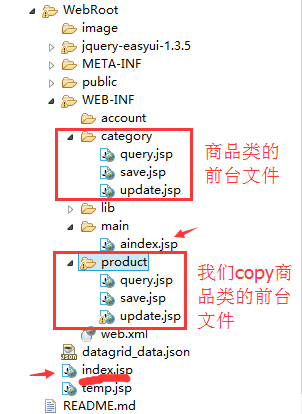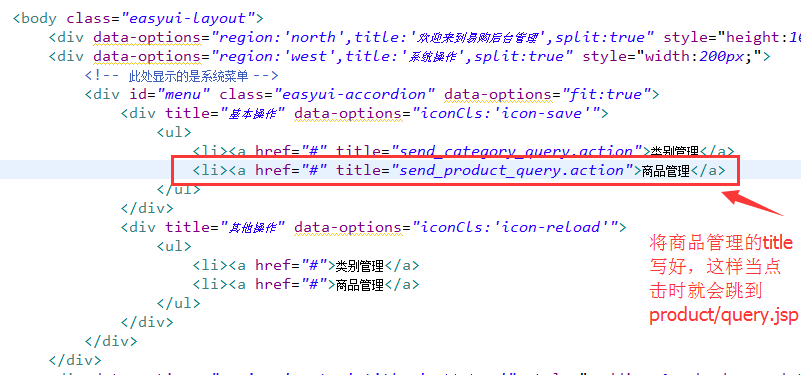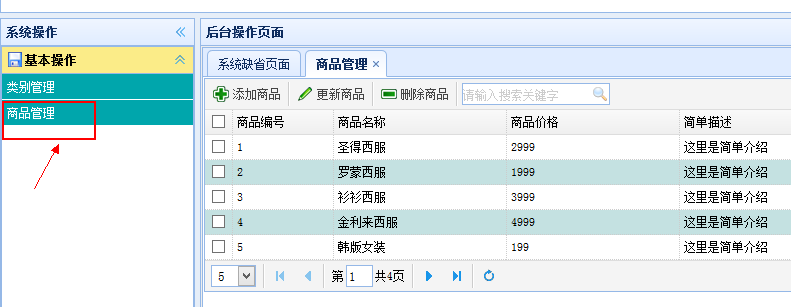前面我们完成了与商品类别相关的业务逻辑,接下来我们开始做具体商品部分。
1. 数据库建表并映射Model
首先我们在数据库中新建一张表,然后使用逆向工程将表映射成Model类,表如下:
- /*=============================*/
- /* Table: 商品表结构 */
- /*=============================*/
- create table product
- (
- /* 商品编号,自动增长 */
- id int primary key not null auto_increment,
- /* 商品名称 */
- name varchar(20),
- /* 商品价格 */
- price decimal(8,2),
- /* 商品图片 */
- pic varchar(200),
- /* 商品简单介绍 */
- remark longtext,
- /* 商品详细介绍 */
- xremark longtext,
- /* 商品生产日期 */
- date timestamp default CURRENT_TIMESTAMP,
- /* 是否为推荐商品,推荐商品才有可能显示在商城首页 */
- commend bool,
- /* 是否为有效商品,有效商品才有可能显示在商城首页 */
- open bool,
- /* 商品所在的类别编号*/
- cid int,
- constraint cid_FK foreign key(cid) references category(id)
- );
使用逆向工程映射为Model类就不赘述了,前面有提到如何使用逆向工程生成Model。
2. 完成商品类的Service层和Action的架构
2.1 商品类的Service层架构
与前面category一样,product也得有个service来操作与商品相关的业务逻辑,所以我们得写一个ProductService和ProductServiceImpl的架构出来,具体如下:
- //ProductService接口继承BaseService<Product>
- public interface ProductService extends BaseService<Product> {
- }
- //ProductServiceImpl实现类继承BaseServiceImpl<Product>,并实现上面的ProductService接口
- @Service("productService")
- public class ProductServiceImpl extends BaseServiceImpl<Product> implements ProductService {
- }
2.2 商品类的Action架构
首先得完善一下BaseAction中关于Service层的注解
- @Controller("baseAction")
- @Scope("prototype")
- public class BaseAction<T> extends ActionSupport implements RequestAware,SessionAware,ApplicationAware,ModelDriven<T> {
- @Resource
- protected ProductService productService;
- //其他代码省略,还是原来的代码……
- }
然后我们写一个ProductAction继承该方法:
- public class ProductAction extends BaseAction<Product> {
- }
至此,关于商品的后台架构就基本搭建好了,接下来就是完善里面的具体功能和业务逻辑了。
3. 完成前台的基本结构
前台的基本结构和商品类的一样,我们看一下已经完成的商品类的前台都有哪些文件:

我们先根据其商品类的前台文件,拷贝一份到product文件夹中,然后我们再做相应的修改。先来分析一下流程:首先index.jsp到aindex.jsp显示左侧菜单栏,当点击类别管理时,进入category/query.jsp页面右侧显示所有商品类别信息,搜索和删除功能均在此页面,不需要弹出新的窗口,添加弹出save.jsp窗口,更新弹出update.jsp窗口。当点击商品管理的时候,进入product/query.jsp页面右侧显示所有商品信息,搜索和删除功能均在此页面完成,添加和更新分别弹出save.jsp和update.jsp。接下来我们把各个页面的框架搭建好,然后往相应的部分填东西即可。
首先在aindex.jsp中添加如下代码:

接下来,我们完成query.jsp的框架:
- <%@ page language="java" import="java.util.*" pageEncoding="UTF-8"%>
- <!DOCTYPE HTML PUBLIC "-//W3C//DTD HTML 4.01 Transitional//EN">
- <html>
- <head>
- <%@ include file="/public/head.jspf" %>
- <style type="text/css">
- body {
- margin: 1px;
- }
- .searchbox {
- margin: -3;
- }
- </style>
- <script type="text/javascript">
- $(function(){
- $('#dg').datagrid({
- //url地址改为请求productAction中的queryJoinCategory方法
- url:'product_queryJoinCategory.action',
- loadMsg:'Loading......',
- queryParams:{name:''},//这里参数改成name,参数值为空,表示我们要显示所有商品,后台是根据商品name属性查询的
- //width:300,
- fitColumns:true,
- striped:true,
- nowrap:true,
- singleSelect:false,
- pagination:true,
- pageSize:5,
- pageList:[5,10,15,20],
- idField:'id',//指定id为标识字段,在删除,更新的时候有用,如果配置此字段,在翻页时,换页不会影响选中的项
- //toolbar定义添加、删除、更新按钮以及搜索框
- toolbar: [{
- iconCls: 'icon-add',
- text:'添加商品',
- handler: function(){
- //添加触发代码
- }
- },'-',{
- iconCls: 'icon-edit',
- text:'更新商品',
- handler: function(){
- //添加触发代码
- }
- },'-',{
- iconCls: 'icon-remove',
- text:'删除商品',
- handler: function(){
- //添加触发代码
- }
- },'-',{ //查询按钮不是LinkButton,它有语法,但是也支持解析HTML标签
- text:"<input id='ss' name='serach' />"
- }],
- rowStyler: function(index,row){
- console.info("index" + index + "," + row)
- if(index % 2 == 0) {
- return 'background-color:#fff;';
- } else {
- return 'background-color:#c4e1e1;';
- }
- },
- frozenColumns:[[
- {field:'checkbox',checkbox:true},
- {field:'id',title:'商品编号',width:100}
- ]],
- columns:[[
- {field:'name',title:'商品名称',width:100},
- {field:'price',title:'商品价格',width:100},
- {field:'remark',title:'简单描述',width:100},
- {field:'xremark',title:'详细描述',width:100},
- {field:'date',title:'上架时间',width:100},
- {field:'commend',title:'推荐商品',width:100,
- formatter: function(value,row,index){
- if(value) {
- return "<input type='checkbox' checked='checked' disabled='true'";
- } else {
- return "<input type='checkbox' disabled='true'";
- }
- }
- },
- {field:'open',title:'有效商品',width:100,
- formatter: function(value,row,index){
- if(value) {
- return "<input type='checkbox' checked='checked' disabled='true'";
- } else {
- return "<input type='checkbox' disabled='true'";
- }
- }
- },
- {field:'category.type',title:'所属商品类别',width:200, //category.type是商品类别
- formatter: function(value,row,index){
- if(row.category != null && row.category.type != null) {
- return row.category.type; //如果商品类别不为空,返回商品类别
- } else {
- return "此商品暂时未分类";
- }
- }
- }
- ]]
- });
- //把普通的文本框转化为查询搜索文本框
- $('#ss').searchbox({
- //触发查询事件
- searcher:function(value,name){ //value表示输入的值
- //添加触发代码
- },
- prompt:'请输入搜索关键字'
- });
- });
- </script>
- </head>
- <body>
- <table id="dg"></table>
- </body>
- </html>
接下来我们完成productAction中的queryJoinCategory方法,在这之前,先要完成service部分,我们都是先从底层慢慢往上开发的:
- //ProductService接口
- public interface ProductService extends BaseService<Product> {
- //查询商品信息,级联类别
- public List<Product> queryJoinCategory(String type, int page, int size); //使用商品的名称查询
- //根据关键字查询总记录数
- public Long getCount(String type);
- }
- @SuppressWarnings("unchecked")
- @Service("productService")
- public class ProductServiceImpl extends BaseServiceImpl<Product> implements ProductService {
- @Override
- public List<Product> queryJoinCategory(String name, int page, int size) {
- String hql = "from Product p left join fetch p.category where p.name like :name";
- return getSession().createQuery(hql)
- .setString("name", "%" + name + "%")
- .setFirstResult((page-1) * size) //从第几个开始显示
- .setMaxResults(size) //显示几个
- .list();
- }
- @Override
- public Long getCount(String name) {
- String hql = "select count(p) from Product p where p.name like :name";
- return (Long) getSession().createQuery(hql)
- .setString("name", "%" + name + "%")
- .uniqueResult(); //返回一条记录:总记录数
- }
- }
下面可以完成productAction中的queryJoinCategory方法了:
- @Controller("productAction")
- @Scope("prototype")
- public class ProductAction extends BaseAction<Product> {
- public String queryJoinCategory() {
- System.out.println("name:" + model.getName());
- System.out.println("page:" + page);
- System.out.println("rows:" + rows);
- //用来存储分页的数据
- pageMap = new HashMap<String, Object>();
- //根据关键字和分页的参数查询相应的数据
- List<Product> productList = productService.queryJoinCategory(model.getName(), page, rows);
- pageMap.put("rows", productList); //存储为JSON格式
- //根据关键字查询总记录数
- Long total = productService.getCount(model.getName());
- // System.out.println(total);
- pageMap.put("total", total); //存储为JSON格式
- return "jsonMap";
- }
- }
接下来在struts.xml中进行配置,跟之前的商品类一样的流程,到这里可以看出,开发好了一个,下面一个就快了:
- <action name="product_*" class="productAction" method="{1}">
- <result name="jsonMap" type="json">
- <param name="root">pageMap</param>
- <param name="excludeProperties">
- <!-- rows[0].category.account -->
- <!-- 把所有account过滤掉,否则会出现懒加载问题,该部分下面截图 -->
- </param>
- </result>
- </action>
![]()
这样后台程序写好了,然后开启tomcat,测试一下,当我们点击左侧菜单栏的商品管理时,会弹出右边如下窗口:

这样我们就完成了商品管理窗口的框架了。